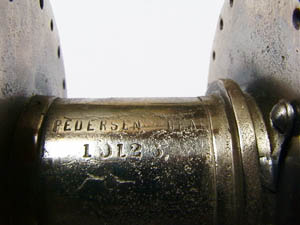Three speed & Two speed gear
Quoted from: "The Ingenious Mr. Pedersen" by David E. Evans.
The hub gear, when first introduced (1903, patented in 1902), must have been a wheel builder's nightmare because of the pear shaped flanges.
 |
| Sectional illustration of the Pedersen frictionless three speed gear. |
| 1905 cataloque |
The pear shaped flanges required, it is said, twelve different lengths of spoke and although the company provided spoking charts they were not popular with wheel builders of other firms. A letter in October 1907 from W.J.Ashworth, then Commercial Manager of the Pedersen Works, to Mikael Pedersen, states that manufacturers were "disgusted" with the trouble in building these hubs into wheels and were refusing to buy. By 1909 both flanges were circular.
The gear like the saddle had its converts. "The Southhampton Times and Hampshire Express" in 1904 extolled the virtues of the gear in a long article.
 |
| Gear shifter |
After stressing these and explaining its principles it remarked "to alter the gear is extremely simple. It requires about as much exertion as is necessary in turning on the electric light and what could be more easy than that?"
The gear gave a 50% increase with each change upwards, which suited some people but not others. the gear tables bellow are representative. The 2 speed gears were 3 speed gears with out the low range.
 |
| Sectional illustration of the Pedersen frictionless two speed gear. |
| 1905 cataloque |
![]()
Its been said that you can recognize a Pedersen gear by the malfunction of one of the speeds. (MR)
 |
| Three speed gear showing pear shape flanges of pre 1907 |
| Photo: B.J. Ashworth |
 |
Enlarge photo (30kb) |
| 3-sp D-P hub from 1912 | |
| Photo: Jack Bissel |
 |
Enlarge photo (57kb) |
| 3-sp D-P hub from 1912 | |
| Photo: Jack Bissel |
 |
Enlarge photo (56kb) |
| 3-sp D-P hub from 1912 | |
| Photo: Jack Bissel |
Gear tables
Table #1
| 1 inch and 1/2 inch pitch | ||||||||||
|---|---|---|---|---|---|---|---|---|---|---|
| Number of teeth on bottom Bracket Wheel | For 26 in. Back Wheel | For 28 in. Back Wheel | ||||||||
| Number of teeth on Hub Chain Wheel |
Number of teeth on Hub Chain Wheel |
|||||||||
| 9*1 or 18*1/2 | 10*1 or 20*1/2 | 9*1 or 18*1/2 | 10*1 or 20*1/2 | |||||||
| Low | High | Low | High | Low | High | Low | High | |||
| 20 21 22 23 24 25 26 27 28 |
or | 40 42 44 46 48 50 52 54 56 |
58 61 64 66 69 73 75 78 81 |
87 91 96 100 103 109 112 117 121 |
52 54 1/2 57 59 1/2 62 65 67 69 1/2 72 |
78 82 85 93 97 100 104 108 |
62 65 68 71 75 78 81 84 87 |
93 97 102 106 112 117 121 126 130 |
56 59 62 65 68 70 73 76 79 |
84 86 93 97 102 105 107 114 118 |
Table #2
| 1 inch and 1/2 inch pitch | ||||||||
|---|---|---|---|---|---|---|---|---|
| Number of teeth on bottom Bracket Wheel | Number of teeth on Hub Chain Wheel |
|||||||
| 8*1'' 16*1/2'' | 9*1'' 18*1/2''' | |||||||
| Low | Medium | High | Low | Medium | High | |||
| 20 21 22 23 24 25 26 27 28 |
or | 40 42 44 46 48 50 52 54 56 |
47 49 52 53 56 58 61 63 66 |
70 73 77 80 84 87 91 94 98 |
105 109 115 120 126 130 136 141 147 |
42 43 45 47 50 52 54 56 58 |
62 65 68 71 75 78 81 84 87 |
93 97 102 106 112 117 121 126 130 |
Table #3
| 5/8 inch pitch | ||||
|---|---|---|---|---|
| Number of teeth on bottom Bracket Wheel | For 26 in. Back Wheel | For 28 in. Back Wheel | ||
| Number of teeth on Hub Chain Wheel | Number of teeth on Hub Chain Wheel | |||
| 15*5/8'' pitch | 15*5/8'' pitch | |||
| Low | High | Low | High | |
| 30 32 34 36 38 40 42 44 46 |
52 56 59 62 66 69 73 76 80 |
78 83 88 93 99 103 109 114 120 |
56 59 63 67 71 75 78 82 85 |
84 88 94 100 106 112 117 123 127 |
Table #4
| 5/8 inch pitch | ||||||
|---|---|---|---|---|---|---|
| Number of teeth on bottom Bracket Wheel | Number of teeth on Hub Chain Wheel |
|||||
| 13 | 15 | |||||
| Low | Medium | High | Low | Medium | High | |
| 30 32 34 36 38 40 42 44 46 |
43 46 49 52 55 58 60 63 66 |
64 69 73 77 82 86 90 94 99 |
99 103 109 115 123 129 135 141 148 |
38 40 42 45 48 50 52 55 57 |
56 59 63 67 71 75 78 82 85 |
84 88 94 100 106 112 117 123 127 |
John Pinkerton Memorial Publishing Fund
Has published a booklet (48 pages) on "The Pedersen Hub Gear" by Cyril J Hancock.
Read more and order here.
